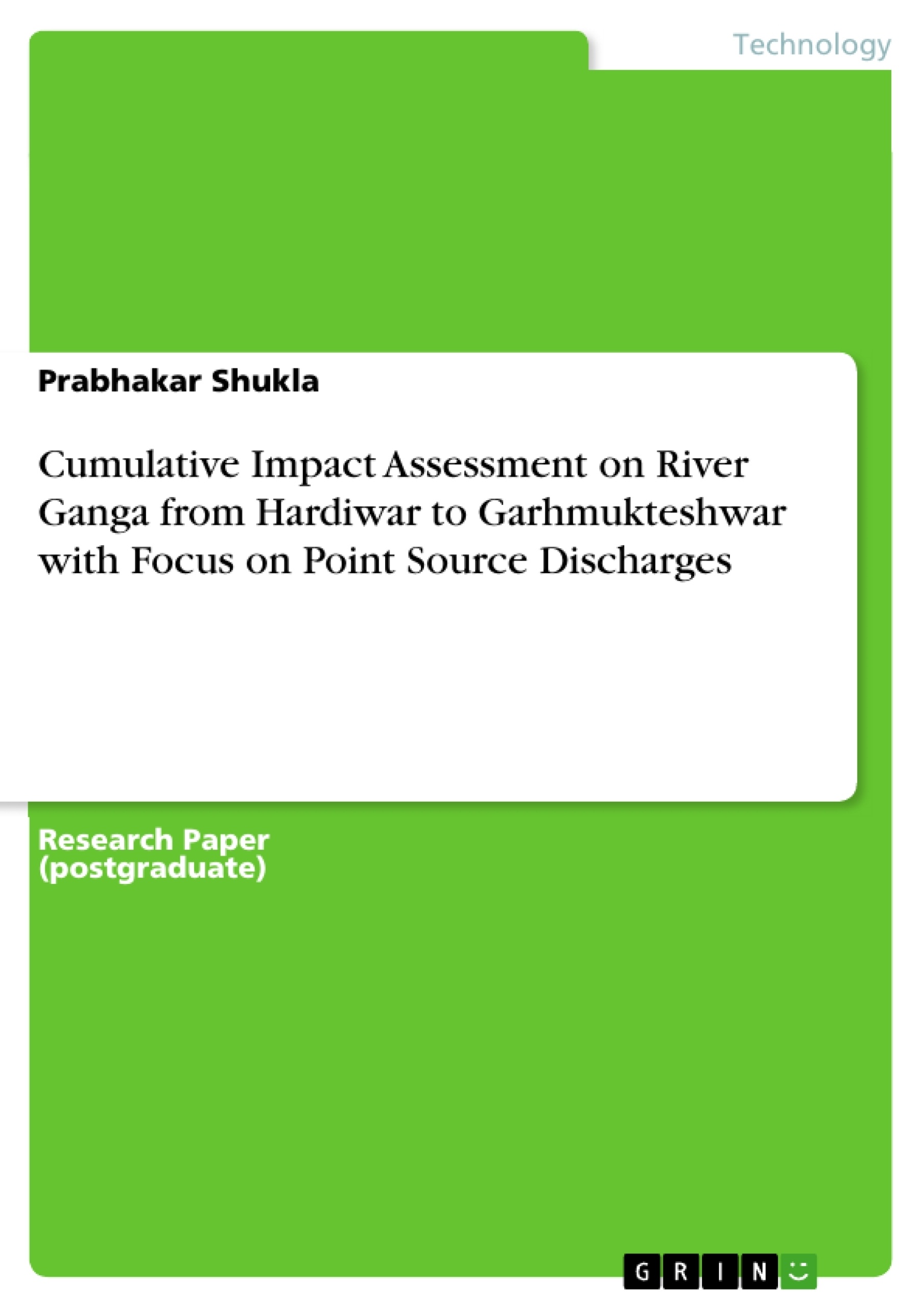There has been necessary to assess the cumulative effects of pollution Sources on river rather only assessment of each human activity and project in isolation. Based on availability of data and time constraint, study of three valued environmental components river water quality, river flow and fluid plain was carried out. This study aims for assessing the cumulative impacts of point Source discharges in river Ganga catchment from Haridwar to Garhmukteshwar (160 km) on these valued environmental components by using different methods such as for water quality, water quality modeling software QUAL2K, and for river flow, modified tenant and flow duration curve shifting methods for the assessment of environmental flow in river stretch. While for flood plain valued environmental component, qualitative method (matrix method) have been used for assessment of cumulative impact of various activities on flood plain VEC. The result shown that QUAL2K model simulation for future prediction during non-monsoon period River stretch will be affected due to severe degradation of water quality at various sites. Environmental flow assessment using hydrological methods (modified tennat method and flow duration curve shifting method) revealed that in months of lean flow river flows do not meet the requirement of minimal flow required to maintain the river environment in desirable state. Impacts on flood plain valued ecosystem component as another VEC shows that river flood plain was also severely affected.
Inhaltsverzeichnis (Table of Contents)
- INTRODUCTION
- STUDY AREA
- METHODOLOGY
- CUMULATIVE IMPACT ASSESSMENT
- River flow Valued Environmental Component
- Methodologies for assessment of environmental flows requirement
- Cumulative Impact Assessment Method for Flood Plain VEC
- RESULT
- Environmental flow assessment of river Ganga from Haridwar to Garhmukteshwar
- Modified Tennat Methodor Tessman method:
Zielsetzung und Themenschwerpunkte (Objectives and Key Themes)
This study aims to assess the cumulative impacts of point source discharges in the River Ganga catchment from Haridwar to Garhmukteshwar (160 km) on valued environmental components, including water quality, river flow, and floodplain ecosystems. It investigates the effects of various human activities on these components, considering both the present status and future predictions.
- Cumulative impact assessment of pollution sources on the River Ganga.
- Analysis of water quality, river flow, and floodplain ecosystem health.
- Evaluation of the impact of point source discharges on valued environmental components.
- Application of modeling tools and hydrological methods to assess environmental flow requirements.
- Identification and assessment of human activities affecting the River Ganga ecosystem.
Zusammenfassung der Kapitel (Chapter Summaries)
The introduction provides background information on the River Ganga, its significance, and the concept of cumulative impact assessment. It highlights the importance of considering the combined effects of various activities on the environment. The study area focuses on the stretch of the River Ganga from Haridwar to Garhmukteshwar, outlining its geographical characteristics and the human activities within its catchment.
The methodology details the steps involved in the cumulative impact assessment, including identification of key issues, selection of valued environmental components (VECs), establishment of temporal and geographic scope, estimation of pollution load, and finally, the assessment of cumulative impacts. The study adopts a regional level approach, encompassing the entire catchment.
The cumulative impact assessment section elaborates on the methods used to evaluate the impacts on water quality, river flow, and floodplain ecosystems. For water quality, the QUAL2K model is employed to predict future water quality based on current status and pollution load. For river flow, hydrological methods, such as the Modified Tennat Method and Flow Duration Curve Shifting Method, are used to assess the environmental flow requirements.
The chapter on results presents the findings of the environmental flow assessment using hydrological methods, comparing the recommended environmental flows with actual flows at the outlet point (Garhmukteshwar). The Modified Tennat Method, which considers monthly variability and flow regimes, is discussed in detail.
Schlüsselwörter (Keywords)
The study's core concepts revolve around the environmental impacts of human activities on the River Ganga. Key terms include environmental components, cumulative impacts, valued ecosystem component (VEC), water quality, river flow, flood plain, QUAL2K model, hydrological methods, and environmental flow assessment. The research focuses on quantifying the cumulative effects of point source discharges on the River Ganga ecosystem.
- Quote paper
- Prabhakar Shukla (Author), 2014, Cumulative Impact Assessment on River Ganga from Hardiwar to Garhmukteshwar with Focus on Point Source Discharges, Munich, GRIN Verlag, https://www.grin.com/document/283774



